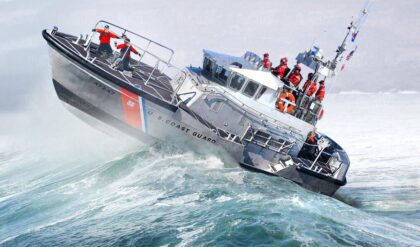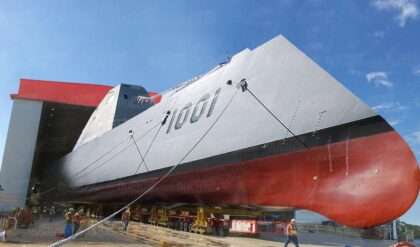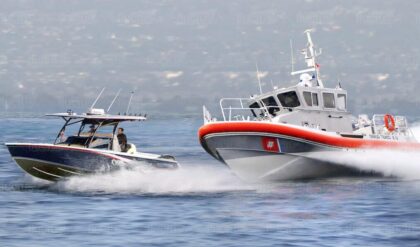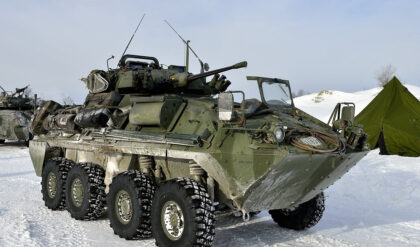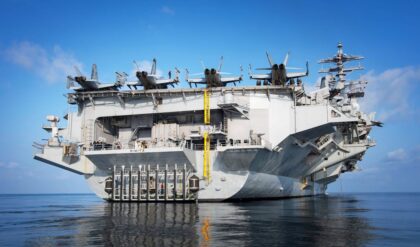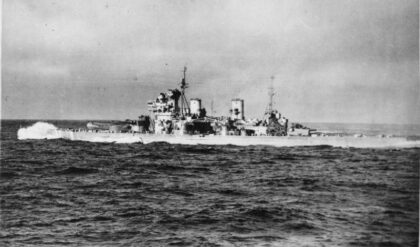The Japanese battleship Musashi, one of the largest and most heavily armed battleships ever constructed, served as a symbol of Imperial Japan’s naval power during World War II.
Despite her formidable design, featuring the largest caliber naval guns ever mounted on a warship and extensive armor, Musashi was sunk in the Battle of Leyte Gulf in 1944.
Design of the Musashi
The design and construction of the Japanese battleship Musashi were monumental undertakings that pushed the boundaries of naval architecture and engineering of the time.
Musashi, alongside her sister ship Yamato, was conceived in the context of an escalating arms race leading up to World War II.
Japan sought to counter the naval capabilities of potential adversaries, particularly the United States, with battleships that combined superior firepower, armor, and speed in unprecedented proportions.
This ambition was encapsulated in the Musashi, whose design and construction were shrouded in secrecy to prevent intelligence leaks to foreign powers.
The strategic doctrine of the Imperial Japanese Navy (IJN) in the interwar period emphasized the decisive engagement of enemy fleets with superior battleship forces.
This doctrine was rooted in the belief that a decisive naval battle in the Pacific would determine the outcome of any future conflict with the United States.
Consequently, the IJN focused on creating battleships that could outgun and outlast their American counterparts.
The Washington Naval Treaty and the subsequent London Naval Treaty imposed limitations on naval armaments, but Japan eventually withdrew from these treaties, freeing itself from any restrictions and paving the way for the construction of the Musashi and Yamato.
Musashi’s design was a masterpiece of naval engineering, embodying the zenith of battleship technology.
The ship’s design team, led by naval architects at the Mitsubishi Nagasaki shipyards, faced the challenge of creating a battleship that could carry the largest guns ever mounted on a warship, while also providing enough armor to protect against similar weapons.
 The Musashi pictured in 1944, on her way to participate in Leyte Gulf.
The Musashi pictured in 1944, on her way to participate in Leyte Gulf.
The solution was a ship of immense proportions: Musashi had a length of 263 meters (862 feet), a beam of 38.9 meters (127 feet), and a full load displacement of approximately 72,800 tons, making her one of the largest battleships ever built.
The centerpiece of Musashi’s design was her main battery of nine 46 cm (18.1 inch) Type 94 naval guns, the largest caliber guns ever fitted to a warship.
These guns were capable of firing shells weighing over 1.5 tons at a range of up to 42 kilometers (26 miles), giving Musashi the ability to strike targets far beyond the reach of most naval artillery of the era.
Her secondary armament included a complement of 155 mm guns, numerous anti-aircraft guns of various calibers, and later modifications for improved air defense.
Musashi’s armor scheme was equally impressive. Her side armor belt, up to 410 mm (16.1 inches) thick, was designed to withstand hits from heavy caliber naval guns. The armor extended well below the waterline to protect against underwater explosions and torpedoes.
Her deck armor was also substantial, designed to fend off aerial bombs and plunging fire from long-range engagements.
The protection extended to vital areas such as the ammunition magazines and the propulsion system, with intricate compartmentalization to enhance survivability in the event of damage.
The construction of Musashi began in 1938 in utmost secrecy.
The shipyard was shielded from aerial observation, and workers were sworn to secrecy to prevent espionage.
The construction process involved innovative techniques and the mobilization of vast resources, reflecting Japan’s industrial capabilities at the time.
Musashi’s keel was laid down in a specially constructed drydock, and her assembly involved thousands of workers over several years.
Musashi’s launch on November 1, 1940, was a significant event, attended by high-ranking naval officers and government officials.
Her fitting-out period involved the installation of her massive guns, armor plates, and the complex machinery required to operate such a large vessel.
Operational History
The operational history of the Japanese battleship Musashi, though relatively short-lived, was a significant chapter in the annals of naval warfare during World War II.
Commissioned in August 1942, Musashi entered service at a critical juncture in the Pacific War, when the balance of naval power was increasingly shifting away from battleships to air power and aircraft carriers.
Despite this, Musashi, as one of the two largest and most powerful battleships ever constructed, was a symbol of Imperial Japan’s naval might and a key asset in its strategic operations.
Initially, Musashi served as a strategic deterrent, anchoring the Combined Fleet’s striking power.
Her first year of service was marked by training exercises and a few sorties in response to American naval movements, but she saw no combat.
The immense resources required to operate such a large battleship, including fuel consumption, limited her operational deployment, especially as Japan began to experience shortages.
In early 1943, Admiral Isoroku Yamamoto, commander of the Combined Fleet, chose Musashi as his flagship. From her bridge, Yamamoto directed fleet movements and strategy.
However, Musashi’s tenure as the flagship was marred by tragedy when Yamamoto was killed in April 1943, while on a tour via aircraft, an event that led to her replacement as the flagship but underscored her importance within the IJN hierarchy.
 Musashi in the foreground, with her sister ship, the Yamato, in the background. Moored in Truk Lagoon in 1943.
Musashi in the foreground, with her sister ship, the Yamato, in the background. Moored in Truk Lagoon in 1943.Despite her formidable capabilities, Musashi’s opportunities to engage in the kind of decisive naval gun battles for which she was designed were limited by the nature of the Pacific War, which increasingly favored aircraft carriers and air power over traditional battleship engagements.
Her role in the Battle of the Philippine Sea in June 1944 was indicative of this shift.
Musashi participated in this battle, one of the largest carrier battles in history, but her role was peripheral.
The battle was dominated by aircraft, and the Japanese fleet suffered heavy losses, particularly in planes and carriers, without Musashi being able to bring her main guns to bear in a significant way.
Sinking of the Musashi
The Battle of Leyte Gulf, spanning from October 23 to 26, 1944, stands as one of the largest naval battles in history and a pivotal engagement of World War II. It was within this colossal conflict that the Japanese battleship Musashi met her demise.
This battle, involving hundreds of ships and thousands of aircraft from both the Allied and Japanese forces, was part of the United States’ efforts to recapture the Philippines, a strategic move that aimed to cut off Japan from its occupied territories in Southeast Asia and the Pacific.
Musashi, as part of Admiral Takeo Kurita’s powerful Center Force, was tasked with attacking the Allied invasion forces in Leyte Gulf.
This force, which included the Musashi’s sister ship, Yamato, and several other capital ships, aimed to deliver a crippling blow to the Allied naval and amphibious forces, hoping to turn the tide of the war in the Pacific in favor of Japan.
The Center Force passed through the Sibuyan Sea to reach its objective, a move that exposed it to American submarine and aerial attacks.
On October 24, 1944, as Kurita’s force made its way through the Sibuyan Sea, it was spotted by American submarines and reconnaissance aircraft.
The presence of such a formidable force in the Sibuyan Sea triggered a massive response from the U.S. Third Fleet, commanded by Admiral William F. Halsey.
American carrier-based aircraft were dispatched in waves to attack the Japanese fleet, with the Musashi quickly becoming one of the primary targets due to her size and the symbolic value of sinking one of Japan’s mightiest battleships.
 The Musashi under attack during the Battle of Leyte Gulf.
The Musashi under attack during the Battle of Leyte Gulf.
Throughout the day, Musashi was subjected to relentless attacks from American aircraft.
The ship’s anti-aircraft defenses fought desperately to repel the attackers, but the sheer volume of incoming torpedoes and bombs overwhelmed these defenses.
Musashi’s armor, the thickest of any battleship ever built, was penetrated multiple times by torpedoes and bombs.
The damage inflicted was severe; Musashi suffered from extensive flooding, fires, and the loss of propulsion, which greatly reduced her maneuverability and made her an even easier target for subsequent attacks.
Despite the valiant efforts of her crew to save the ship, including counter-flooding to correct a dangerous list and attempting to shoot down incoming aircraft, the damage was irreparable.
The final blow came in the late afternoon when it became clear that Musashi could no longer be saved.
Admiral Kurita gave the order to abandon ship, prioritizing the rescue of the crew.
At approximately 19:36 on October 24, 1944, Musashi sank into the depths of the Sibuyan Sea. Of her crew of nearly 2,400 men, 1,023 were lost with the ship.
Musashi’s wreckage, lying deep in the Sibuyan Sea, was rediscovered in 2015.
